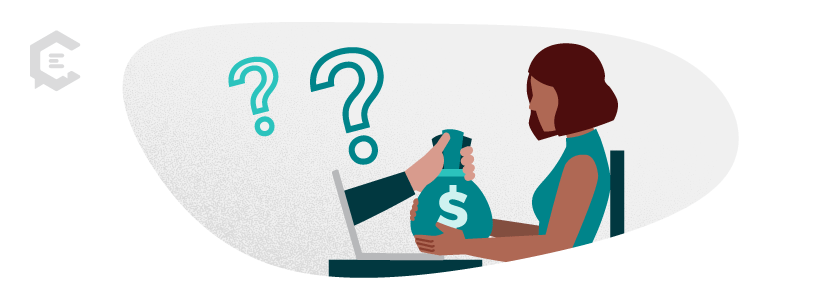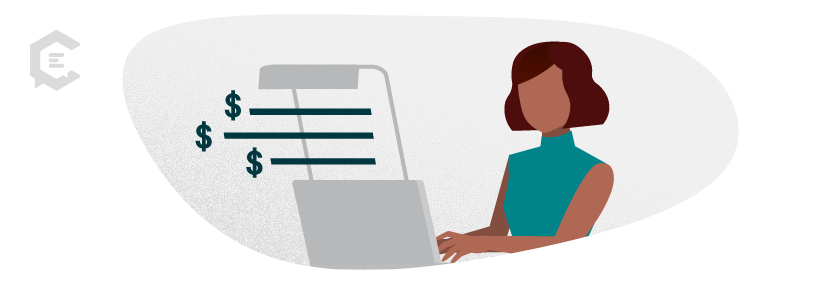At ClearVoice, we probably get asked this question more than any other: “How much should I pay for a freelance writer?” As creating content for marketing becomes more popular, everyone wants to know what the going freelance pay rates are for well-written blog posts, email newsletters, social media content, and eBooks.
On the flip side, we know freelancers are curious about how they stack up to others in terms of pay. Let’s face it, it’s a seldom-spoken topic. If you do a quick search on pay for freelance writers, you’ll see that many other publications begin to answer this question, but most fail to actually list any rates. That’s because the answer depends on many factors, but it’d still be nice to see some actual numbers.

How much should you pay a freelance writer for your marketing content?
This FAQ doesn’t have a simple answer. Most intermediate to advanced freelance writers charge between $0.10 and $1 per word, depending on the amount of work they will have to put into the project. But, the way they bill that average range will vary. Some freelance writers bill at a flat rate, per hour, or per monthly retainer for frequent work (in this case, a volume-based discount should apply), rather than per word. Typically, freelance writers who use one of those last three billing methods will include services beyond just the content.
In addition, rates change per industry, company, writer, location, and project (and many other variables), which is probably why this question often goes unanswered on the Interwebs. But, that’s not helpful for anyone.
Freelance writing rates explained
So we decided the best way to give you a useful answer on freelance writing rates was to ask freelance writers themselves what they charge:

Methodology of our freelance writer payment survey
We addressed a big question in content marketing: How much should you pay freelance writers? Or, if you are a freelance writer, how much should you charge? It’s kind of hard to know unless someone tells you, right?
The best way to get an answer to “how much to pay a freelance writer” was to take it to the streets. We polled 500+ freelance writers from around the country to see what they charge, how they charge, what type of content they produce, the corresponding level of experience, and even gender to see if a gap exists like in so many other industries.
Questions we asked in our survey on freelance writing rates:
1. How many years of experience do you have as a professional freelance writer?
- Beginner — 0–3 years’ experience
- Intermediate — 3–7 years’ experience
- Professional — 7–15 years’ experience
- Expert — 15+ years’ experience
2. How do you charge?
- Per hour
- Per word
- Retainer/ project fee
- A mix — depends on the client
3. What do you charge per hour? (Approximate if N/A)
- $1–$20
- $21–$40
- $41–$60
- $61–$80
- $81–$100
- Above $100
4. What do you charge per word? (Approximate if N/A)
- $.01–$0.10
- $0.11–$0.25
- $0.26–$0.50
- $0.51–$0.75
- $0.76–$1.00
- $1.00 and above
5. What tasks do you complete for clients?
- Blog posts/articles
- Email newsletters
- Social media content
- Print collateral
- Ebooks/white papers
- Research papers
- Books
- Other [Specify]
6. What is your gender?
- Male
- Female
- Prefer not to answer
Key findings around freelance writer pay, experience, and gender
After months of collecting data from freelancers near and far, we were able to see some pretty cool trends on freelancer pay rates. Some were expected and obvious. Others were a bit surprising.
There were several common themes:
1. You get what you pay for: Rates and level of experience are correlated.
When asked the question, “What do you charge per hour?” rates were cut pretty evenly, aside from the $1 to $20 range.
Here is the breakdown per hour and per word:
Per hour
- $1–$20: 9%
- $21–$40: 19%
- $41–$60: 18%
- $61–$80: 14%
- $81–$100: 19%
- $100+: 21%
Per word
- $0.01 –$0.10: 14%
- $0.11–$0.25: 18%
- $0.26–$0.50: 18%
- $0.51–$0.75: 13%
- $0.76–$1.00: 25%
- 12% did not answer because they did not charge per word.
As we suspected, rates and level of experience are connected. Of the writers who charged the lowest rate, 25% were beginner freelancers, while only 1.5% of expert-level writers charged within that range. In fact, of the writers who charged the highest rate – $100+ per hour – most were experts (41%).
The findings were the same for per-word rates. Of the freelancers who charged between $0.01 and $0.10 per word, 32% were beginner writers, while only 0.8% were experts. And of the writers who charged more than a dollar per word, 54% were experts, while only 5% were beginners.
More on pay rates and quality
Interested in learning more about pay rates, experience, and quality? We previously reported on the correlation between pay rates and quality in our pay rate study for the travel industry and subsequent study for the tech industry. It was no surprise to find that writers with more experience, who charged more, were overwhelmingly better than more affordable, less experienced writers.
2. We found a gender pay gap in our sample that was the opposite of most industries.
Interestingly enough, we didn’t find the traditional gender pay gap in freelance writing, at least in our survey pool. Women, on average, charged more than men except in one category, which was at the intermediate level. When we scale-adjusted the pay ranges to the percentages within each group, it came out to…
Average of all pay levels:
- Women charged an average of 11.7% more per word.
- Women charged an average of 8.3% more per hour.
At the beginner level:
- Women charged an average 25.4% more per word and 37.8% more per hour than men.
At the intermediate level:
- Men charged an average of 5.4% more per word and 6.3% more per hour than women. *It was the only level where men charged more than women.*
At the professional level:
- Women charged an average 20.5% more per word and 11.1% more per hour than men.
At the expert level:
- Women charged an average 11.3% more per word and 5.7% more per hour than men.
Note: Only eight respondents in the survey selected “Prefer not to answer” on the gender question. In future studies, we will add a “non-binary” selection.
3. Most freelance writers are flexible in how they charge.
When asked the question “How do you charge?” freelancers overwhelmingly responded that “it’s a mix – it depends on the client.” In fact, nearly 60% of respondents vary their rates based on different clients, while 12% charge per hour, another 12% by word, and nearly 16% charge by retainer (or per project). This is good news for brands, as budgets and payment terms vary from business to business.
One data point that stuck out was that men were about twice as likely to charge per word than women.
4. No surprise, but articles and blogs are the most common type of content produced.
Overwhelmingly, blogs and articles are the most common type of content produced by freelance writers. In fact, 90% of respondents produce articles and blogs, a rate that was consistent across all experience levels. Here is a breakdown of all the content types in our survey:
- 90% produce blog posts and articles
- 52% produce email newsletters
- 56% produce social media content
- 30% produce “other” types of content
- 26% produce print collateral
- 25% produce ebooks and white papers
- 14% produce research papers
- 13% produce books
- 10% produce website copy
For the most part, men and women produced content types at about the same rate, with one exception: 41% of men reported producing ebooks and white papers while only 25% of women reported the same — the biggest gap for any content type.
5. Counter to popular opinion, older and more experienced freelancers were far more likely to do social media content.
While 80% of experts (those freelance writers with 15+ years of experience) reported doing social media content for clients, substantially fewer beginners, only 47%, reported the same. We found this point to be most surprising, as it counters the notion that social media is dominated by those who are younger. Perhaps putting your brand’s reputation in the hands of a freelancer requires the assurance they are more experienced?
Translating pay rates into the cost of content types
Although charging per word might not be the ultimate method of calculating pay with your freelancers, knowing the approximate word count for the content types you need can help you estimate initial cost figures to work from.
What type of content do you want to produce?
- Blog posts/website articles
- Quality posts should be 800–2,200 words, depending on strategy
- Social media posts
- Typically 5–150 words per post.
- Usually billed monthly or per project for bulk work.
- Intermediate to expert freelancers should include some strategy and research.
- Marketing emails/newsletters
- Typically 100–800 words.
- Usually billed at a flat rate per email.
- Rate could be higher if research, media, distribution, or cross-publishing is required.
- Design is not included in the content rate.
- Business resources (ebooks, white papers, etc.)
- Typical ebooks range from 1,500–5,000+ words, while case studies often range from 300–900 words (usually translating into 1–3 pages for print collateral).
- Ebook writers are often more experienced freelancers (and quite possibly subject matter experts).
- Should always include research, sources, and media.
Parting Words
Sending a special thanks to the hundreds of freelance writers out there who took time out of their day to participate in this study. After viewing the study, we hope freelancers have a better pulse on what others charge. And same goes for brands! Now you should have a better idea of reasonable rates based on levels of experience.
Related articles to help you determine pay and hire quality freelancers:
- 5 Great Reasons to Hire Freelance Writers: Whether you don’t have the time yourself or your team is already overloaded, learn the big benefits of hiring freelance writers.
- The Power of Pay: Are Freelance Rates and Quality Correlated? [TRAVEL STUDY]: We assigned one travel article to seven writers and had 30 editorial pros rate the quality of the submissions. Did vetted experts outperform less experienced writers?
- Survey Results: Factors in Determining Freelance Rates for Different Assignments: Different assignments, different rates, but same freelancer. Do really value and understand your freelancers’ time? If you need more editorial insight on gauging the work that goes into assignments, Jenna Rose Robbins captures many points marketers and newbie publishers need to know from the freelancer’s perspective.
- 15 Scenarios When You Should Pay Freelance Writers More: Developing a solid working relationship with freelancers is no less important than fostering respect with your fellow FTEs. Educate yourself on the most common contingencies and special circumstances that warrant you paying a freelancer above and beyond their normal rate.
And related articles for freelance writers trying to boost their income:
- How to Make $100k or More as a Freelance Writer: Successful Women Share Their Advice: Get ready to make more than ever before after hearing how these freelancers hit the $100k mark—and beyond.
- How to Address Clients When Rates Are Higher Than They Expect: Hear directly from successful freelancers on how they proved their worth to clients and got the rates they deserve.
- How to Grow Your Freelance Writing Rates (and When It’s Time to Ask for More): When you become your own boss: How do you know when you’re due for more money? Learn when to ask clients for more.
Looking to outsource your content? Connect with a content strategist today and discuss your content needs, goals, and budget.







